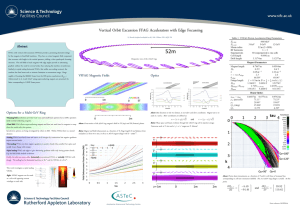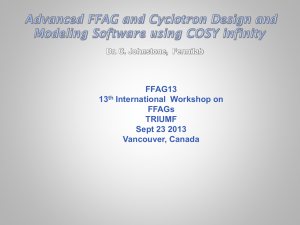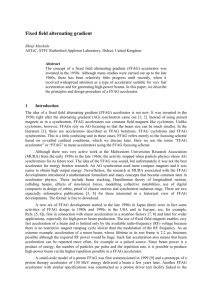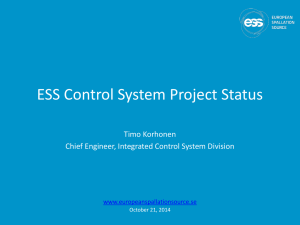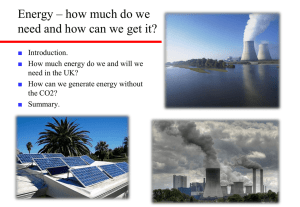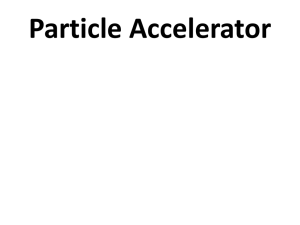DOC - KEK
advertisement
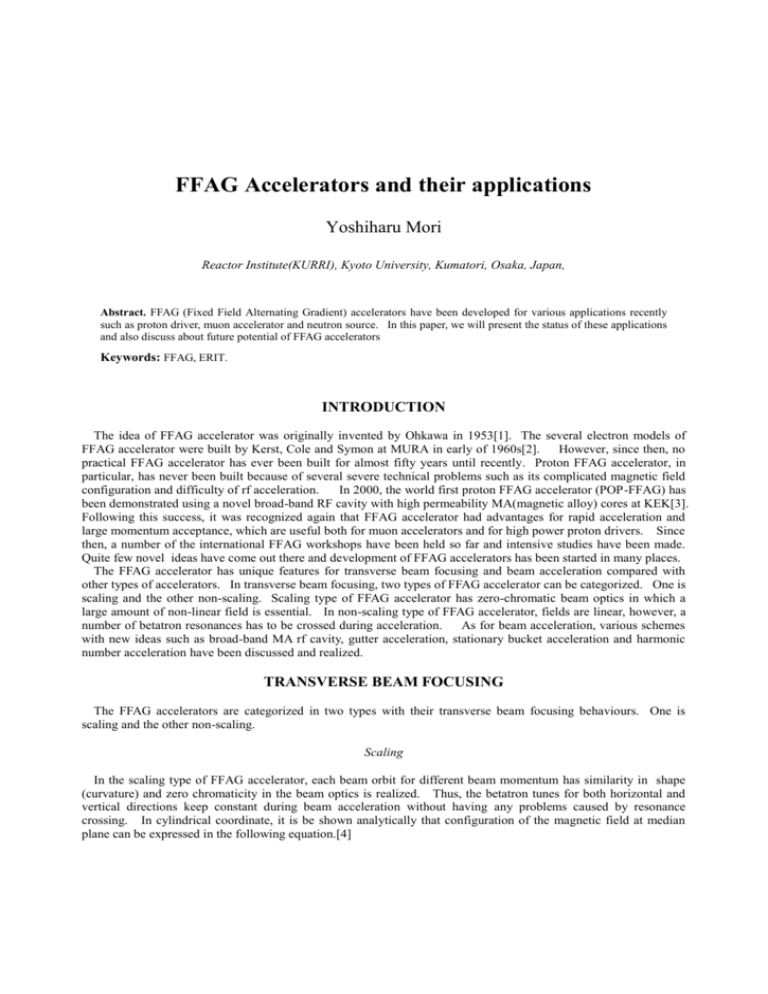
FFAG Accelerators and their applications Yoshiharu Mori Reactor Institute(KURRI), Kyoto University, Kumatori, Osaka, Japan, Abstract. FFAG (Fixed Field Alternating Gradient) accelerators have been developed for various applications recently such as proton driver, muon accelerator and neutron source. In this paper, we will present the status of these applications and also discuss about future potential of FFAG accelerators Keywords: FFAG, ERIT. INTRODUCTION The idea of FFAG accelerator was originally invented by Ohkawa in 1953[1]. The several electron models of FFAG accelerator were built by Kerst, Cole and Symon at MURA in early of 1960s[2]. However, since then, no practical FFAG accelerator has ever been built for almost fifty years until recently. Proton FFAG accelerator, in particular, has never been built because of several severe technical problems such as its complicated magnetic field configuration and difficulty of rf acceleration. In 2000, the world first proton FFAG accelerator (POP-FFAG) has been demonstrated using a novel broad-band RF cavity with high permeability MA(magnetic alloy) cores at KEK[3]. Following this success, it was recognized again that FFAG accelerator had advantages for rapid acceleration and large momentum acceptance, which are useful both for muon accelerators and for high power proton drivers. Since then, a number of the international FFAG workshops have been held so far and intensive studies have been made. Quite few novel ideas have come out there and development of FFAG accelerators has been started in many places. The FFAG accelerator has unique features for transverse beam focusing and beam acceleration compared with other types of accelerators. In transverse beam focusing, two types of FFAG accelerator can be categorized. One is scaling and the other non-scaling. Scaling type of FFAG accelerator has zero-chromatic beam optics in which a large amount of non-linear field is essential. In non-scaling type of FFAG accelerator, fields are linear, however, a number of betatron resonances has to be crossed during acceleration. As for beam acceleration, various schemes with new ideas such as broad-band MA rf cavity, gutter acceleration, stationary bucket acceleration and harmonic number acceleration have been discussed and realized. TRANSVERSE BEAM FOCUSING The FFAG accelerators are categorized in two types with their transverse beam focusing behaviours. One is scaling and the other non-scaling. Scaling In the scaling type of FFAG accelerator, each beam orbit for different beam momentum has similarity in shape (curvature) and zero chromaticity in the beam optics is realized. Thus, the betatron tunes for both horizontal and vertical directions keep constant during beam acceleration without having any problems caused by resonance crossing. In cylindrical coordinate, it is be shown analytically that configuration of the magnetic field at median plane can be expressed in the following equation.[4] r B(r, ) B0 r0 k r f ln r0 , where tan, and is a spiral angle of the magnet in azimuth plane. Accordingly, two schemes for beam . focusing are invoked by this magnetic field configuration: one is radial sector focusing and the other spiral sector focusing. The radial sector focusing uses a combination of positive and negative bending magnets to makes strong beam focusing with FODO lattice configuration. In spiral sector focusing, the edge focusing is used efficiently. Non-scaling Non-scaling type of FFAG accelerator has a basically simple structure composed linear optical elements such as dipole and quadrupole magnets. Transverse betatron tune, however, is not constant during acceleration and fast acceleration is essential in non-scaling type of FFAG accelerator to avoid beam losses caused by resonance crossing. To ensure it, the RF cavity phases are fixed for beam acceleration and the range of times-of-flight over the energy range of the accelerator is minimized when the path length difference has a parabolic dependence on beam momentum. A typical cell structure and path length difference of non-scaling FFAG accelerator are presented in the paper.[5] Based on the concept of linear non-scaling FFAG accelerators, some variations such as isochronous[6] or achromatic lattice [7] including small non-linear elements(semi-scaling) have also been proposed. Acceleration One of the most distinctive features in FFAG accelerators compared with ordinary strong focusing synchrotrons is that very fast acceleration can be allowed because the magnetic field is static. Accordingly, various new RF acceleration schemes, which are adequate either for scaling and non-scaling FFAG accelerators, have been proposed for fast acceleration, and some of them have already been realized. Broad-band RF cavity with MA cores Broad-band RF cavities with high permeability magnetic alloy (MA) cores have been used mostly in scaling type of proton FFAG accelerators such as POP-FFAG developed at KEK. No frequency tuning synchronized with beam revolution is needed and very rapid acceleration cycle of more than 100Hz becomes possible. Stationary RF bucket acceleration RF bucket in scaling type of FFAG accelerators for relativistic particles such as high energy muons is not distorted for large momentum range because the momentum compaction keeps constant and has no momentum dependence. If the RF voltage is large enough, the particles can be accelerated in a stationary RF bucket after a half period of synchrotron oscillation as shown in Fig. 1.[8] Fig. 1 Stationary RF bucket acceleration [8] Gutter RF acceleration In non-scaling FFAG accelerator, fixed frequency RF system is installed and acceleration out of longitudinal buckets(gutter) can be possible for relativistic particles when the path length difference has parabolic dependence on momentum as described above. Figure 2 shows an example of a gutter acceleration.[9] Fig. 2 Trajectory in longitudinal phase space in gutter acceleration.[8] Harmonic number jump In FFAG accelerators, the transverse beam positions change during acceleration. If the energy gain varies properly with transverse position to achieve an integer change in the harmonic number with each turn, the beam can be accelerated with fixed frequency RF system.[9,10] The difficulty of this scheme is how to vary the energy gain properly and several ideas such as position dependent RF voltage configuration have been proposed to overcome this difficulty. Applications Because of their many advantages in FFAG accelerators such as (1) strong focusing, (2) fast acceleration and (3) large acceptance, quite few applications have been invoked. Among them, the second proton FFAG accelerator prototype built at KEK recently (shown in Fig. 3) is an important demonstration showing the abilities of the FFAG accelerators at useful energies for various applications. The beam was successfully accelerated and extracted at 100MeV for 100Hz operation in this machine.[10] In this paper, R&D activities of FFAG accelerators at various institutes for various applications are summarized. Fig. 3 Photo of 150MeV scaling type of FFAG accelerator at KEK. Proton driver In Kyoto University, as a substitute for the 5MW reactor at Research Reactor Institute (KURRI), a neutron source based on the ADS concept has been proposed. Through the studies for this, the lack of reliable multiplication factor keff in the proton energy region between 20MeV and 150MeV was realized. Thus a proton source which covers this energy range is required and an FFAG accelerator complex is under construction[11]. The accelerator composes a chain of three scaling type of FFAG accelerators as shown in Fig. 4. The beam has been accelerated and extracted recently from the first ring which has spiral sector focusing. The machine may also be used for medical applications (proton beam therapy) in the future. Fig. 4 Photo of the FFAG accelerator chain which is under construction at KURRI.[11] Proton drivers based on non-scaling type of FFAG accelerators have been discussed in several institutes. In BNL, several applications have been proposed; an injector to the AGS, a 1GeV 10MW proton dirver, a 11.6GeV 10MW proton dirver for a neutrino factory.[12] These machines use an FDF triplet lattice configuration with linear combined function magnets. An electron model to clarify this scheme has been proposed. A 10GeV 4MW nonlinear and non-scaling FFAG proton driver (NFFAGI) has been proposed at RAL [12] Muon ring Longitudinal phase space rotation to narrow the energy spread of the muon beam by a scaling FFAG ring has been developed to search for lepton-flavor-violating process, which is a “PRISM” project, at Osaka University.[13] A large energy acceptance of a scaling type of FFAG ring allows the phase space rotation of a beam which has an large energy spread initially. A ring consists of 10 magnets and 5 RF cavities with MA cores whose frequency and gradient are 5MHz and 200kV/m, respectively. Both scaling type and non-scaling type of FFAG accelerators have been proposed for muon accelerators in neutrino factory [14][15]. Since linear non-scaling type of FFAG accelerator has never been built, it would be very useful to built an electron model of such a machine in order to test the machine capabilities. Two machines have been proposed recently: an electron model based on muon acceleration parameters (EMMA)[16], and a proton machine to study the use of a linear non-scaling type of FFAG accelerator in medical applications which will be described later. The EMMA is designed with high, fixed RF frequency to test the gutter acceleration and also to look at resonance crossing. Medical Applications Applications of FFAG accelerators in medical use have been proposed for two different fields: hadron beam therapy and boron neutron capture therapy (BNCT). In hadron beam therapy, a rapid cycling acceleration is one of the most interesting features which could allow a spot scanning treatment. A 100Hz operation demonstrated with the scaling type of proton FFAG accelerator at KEK as described above would be a good sign for this direction. A proton model of linear non-scaling type of FFAG accelerator has been proposed for medical applications. This machine will have a final energy in the range of 40 to100MeV and will irradiate tumors in mice to test the performance of this method for cancer treatment. As for BNCT medical applications, an accelerator-based intense thermal or epithermal neutron source has been strongly requested recently. A scaling type of FFAG accelerator with ERIT (energy/emittance recovery internal target) concept has been proposed for this purpose and is now under construction.[17,18] Figure 5 shows a schematic diagram of ERIT. The circulating current of the beam inside of a strong focusing ring accelerator such as FFAG accelerator is fairly large because the same beam bunch orbits the ring many times with large revolution frequency. For example in case of neutron production, when 1x1011 protons at 10MeV orbit inside of a ring of circumference 10m, the circulating beam current in the ring reaches 70mA. The number 1x10 11 protons per bunch is relatively modest for such strong focusing proton accelerators of this energy. If a neutron production internal target such as beryllium thin foil is inserted into the ring and the beam hits the target efficiently, the neutron yield should become comparable with that from a nuclear reactor. Fig.5 Schematic diagram of ERIT. In this scheme, however, the incident proton beam will be lost from the ring very quick because the beam energy of the incident protons is lost to ionization of the target atoms turn by turn, and also because the beam emittance in transverse and longitudinal directions are blown up by multiple scatterings with the target electrons. These deleterious effects, however, can be cured by ionization cooling. The transverse emittance reaches equilibrium because of ionization cooling which is invoked in this energy recovery internal target scheme. For a 11MeV proton beam with 5m beryllium target, the transverse emittance reaches to be about 2500mm.mrad(rms) after 2,500 turns as shown in Fig. 6-(a). In reality, the beam life is limited by the vertical acceptance of the beam. The beam simulations have been carried out with ICOOL and the results are also shown in Fig. 6-(a) . The figure 6-(b) presents the particle survival as a function of turn number. It can be seen from this figure, the average number of turns for beam survival is about 900 turns. (a) (b) Fig. 6 Transverse and longitudinal emittance growth in ERIT. On the other hand, since there is no cooling effect expected in the longitudinal direction, a large energy spread is inevitable. For example, after 1,000turns using the same beryllium target described above, the energy spread of the 10MeV proton beam can be about 10%. In order to circulate such a large transverse and longitudinal emittance beam in the ring, the FFAG accelerator seems to be one of the most suitable accelerators. The FFAG has very large acceptance, especially in momentum space, compared with other types of the ring accelerators, because zero chromaticity in the beam focusing is fulfilled. Moreover, the FFAG is the ring that has the functions both of acceleration and storage, which can be an ideal for the internal target type of secondary particle source and it may be applied for generating not only for neutrons but for other particles such as pions, although the ionization cooling efficiency is small. Summary Recent progress of FFAG accelerator developments and their applications are summarized. Quite few scaling type of FFAG accelerators have been built and commissioned for various applications. A large amount of effort in design work for non-scaling type of FFAG accelerators is being continued. Many novel ideas and various new applications are awaiting for the FFAG accelerators. The author would like to express his great appreciation for all the colleagues who have made their contributions to such exciting accelerator field. ACKNOWLEDGMENTS The author woul like to express his sincere appreciation for FFAG/DDS-ERIT group. References 1. T.Ohkawa, Proc. annual meeting of JPS,1953. 2. K.R.Symon et al., Phys. Rev 103(1956)1837 3. Y.Mori, Proc. EPAC1998,2000,289 4. C.Kolomenski, “Circular Particle Accelerator”, 1960, Oxford, page 346. 5. D.Trbojevic, Proc. of the International Workshop on FFAG Accelerators (FFAG05), Osaka, Japan,2005, page 9. 6. G.Rees, Proc. of the International Workshop on FFAG Accelerators (FFAG04), Tsukuba, Japan, 2004, page 77. 7. A.G. Ruggeiero, Proc. of the International Workshop on FFAG Accelerators (FFAG05), Osaka, Japan, 2005, page 47. 8. Y.Mori, talk at the International Workshop on FFAG Accelerators at FNAL, Chicago, USA, 2005. 9. S.Machida, Proc. of the International Workshop on FFAG Accelerators (FFAG05), Osaka, Japan, 2005, page 68. 10. S.Berg, “Summary of the FFAG05 Workshop at KURRI”, Proc. of the International Workshop on FFAG Accelerators (FFAG05), Osaka, Japan, 2005, page 93. 11. M.Aiba et al.,Proc. EPAC2002,2002,1076.:M.Aiba et al., contribution at this conference, Edinburgh,GB,(EPAC 2006). 12. M.Tanigaki et al., Proc. Cyclotron Conf.,2004,Tokyo,p.1058. M.Tanigaki et al., contribution to EPAC2006. 13. A.G.Ruggiero, Proc. ICFA-HB2004 Workshop, Bensheim, 2004, page 324. 14. A.Sato et al., Proc. of EPAC04, TUPLT081,2004. Y.Mori et al., LOI for Nuclear and Particle Physics Experiments at the J-PARC ,2003. 15. Y.Iwashita et al., NuFactJ working group: “A Feasibility Study of a Neutrino Factory in Japan”, NuFactJ-report, 2001. 16. J.S.Berg, Proc. of the International Workshop on FFAG Aceleerators, FFAG04, Tsukuba, 2004, page 1. J.S.Berg, presentation at the Muon Collaboration Meeting , Riverside,2004, page 27. 17. S.Koshienniak et al. “Report of Working Group I:FFAG for Muon Physics”, Proc. of the International Workshop on FFAG Accelerators (FFAG04), Tsukuba, Japan, 2004, page27. 18. Y.Mori, presentation at the International Workshop of the FFAG Accelerators (FFAG03), Tsukuba,2003. Y.Mori, presentation at AccApp05, Venice, Iatly, 2005. 19. Y.Mori, Nucl. Instr. and Meth, in press, 2006. 20. A.N. Skrinskii & V.V. Parkhomchuk, Sov. J. Part. Nucl., 12, 223 (1981). 21. D.Neuffer, Particle Accelerators 14,75(1983). D.Neuffer, Nucl. Instr. and Meth. A532, p.26(2004.).
